Jigsaw puzzles from Japan
The Attic
Deleted puzzles by artist Ozuma Kaname
This page shows puzzles that are no longer available, just for historical curiosity, and for completeness.
In some cases puzzles are reissued with a different code number: if you have the old code number from somewhere, this page should show you the replacement (which may still be available).
2000 pieces
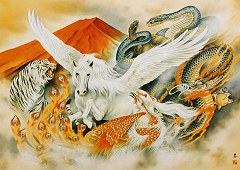 © Ozuma Kaname Lucky white horse (Kaname)A most auspicious painting. We have the white winged horse looking rather handsome, and surrounded by the four gods, with a red Fuji in the background. In case you have difficulty counting the four gods, you have to know that one of them, Genbu, often appears as a snake intertwined with a turtle. 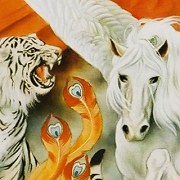 The painter Ozuma Kaname was born in 1939, in Niigata. He studied traditional Japanese art, and his pictures are generally based on traditional themes. Ozuma is his family name: he signs paintings with the single character of his given name only.  Permanently unavailable Permanently unavailableAn Appleone puzzle: 2000 pieces; 1020 x 730 mm (40" x 29") Code: A20041 (2000-041 on package) Retail price ¥5800 |
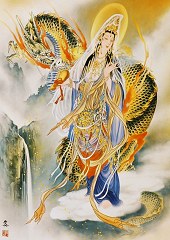 © Ozuma Kaname Cloud Kannon (Kaname)Kannon, the Goddess of Mercy, stands on a cloud, not quite entwined with a rather angry-looking dragon. In her left hand she holds a sprig of rice, and in her right a flask, from which she pours golden grains. Experts in Buddhism say that she isn't the Goddess of Mercy after all, and is Avalokitêsvara, who was a man. Very puzzling. 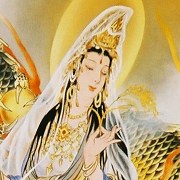 The painter Ozuma Kaname was born in 1939, in Niigata. He studied traditional Japanese art, and his pictures are generally based on traditional themes. Ozuma is his family name: he signs paintings with the single character of his given name only.  Permanently unavailable Permanently unavailableAn Appleone puzzle: 2000 pieces; 730 x 1020 mm (29" x 40") Code: A20042 (2000-042 on package) Retail price ¥5800 |
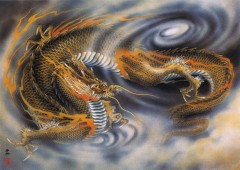 © Ozuma Kaname All-seeing dragon (Kaname)A steely blue belly and ferocious claws make one grateful that the dragon's role is to protect the heavens. The original title is literally "Dragon that sees in eight directions" (the eight cardinal points of the compass), referring to its ability to watch everything at the same time.  The painter Ozuma Kaname was born in 1939, in Niigata. He studied traditional Japanese art, and his pictures are generally based on traditional themes. Ozuma is his family name: he signs paintings with the single character of his given name only.  Permanently unavailable Permanently unavailableAn Appleone puzzle: 2000 pieces; 1020 x 730 mm (40" x 29") Code: A20044 (2000-044 on package) Retail price ¥5800 |
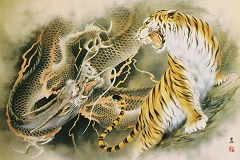 © Ozuma Kaname Dragon vs. tiger (Kaname)The tiger, symbol of fire, and the dragon, symbol of water, are often portrayed as adversaries, representing the heaven-earth or ying-yang dichotomy. Note that the tiger is quite naturalistic, whereas the dragon is an entirely mythical beast, and more like a snake with legs and horns than the giant lizard form of Western dragon. 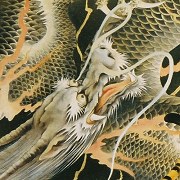 This puzzle is also available in 1000 pieces (code A10311). The painter Ozuma Kaname was born in 1939, in Niigata. He studied traditional Japanese art, and his pictures are generally based on traditional themes. Ozuma is his family name: he signs paintings with the single character of his given name only.  Permanently unavailable Permanently unavailableAn Appleone puzzle: 2000 pieces; 1020 x 730 mm (40" x 29") Code: A20047 (2000-047 on package) Retail price ¥5800 |
1000 pieces
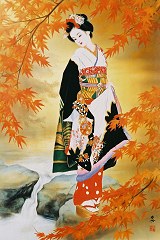 © Ozuma Kaname Maples (Kaname)Framed by red maples, this lady wears a striking kimono. The original title, Gion-no-komachi implies that she is a beauty from Gion, the traditional geisha area of Kyoto. 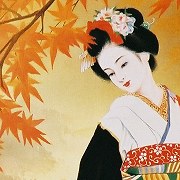 The painter Ozuma Kaname was born in 1939, in Niigata. He studied traditional Japanese art, and his pictures are generally based on traditional themes. Ozuma is his family name: he signs paintings with the single character of his given name only.  Permanently unavailable Permanently unavailableAn Appleone puzzle: 1000 pieces; 500 x 750 mm (20" x 30") Code: A10309 (1000-309 on package) Retail price ¥3600 |
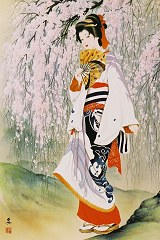 © Ozuma Kaname Cherry blossom (Kaname)A demure beauty poses below a weeping cherry in full flower. 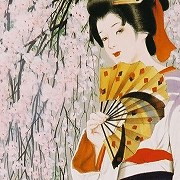 The painter Ozuma Kaname was born in 1939, in Niigata. He studied traditional Japanese art, and his pictures are generally based on traditional themes. Ozuma is his family name: he signs paintings with the single character of his given name only.  Permanently unavailable Permanently unavailableAn Appleone puzzle: 1000 pieces; 500 x 750 mm (20" x 30") Code: A10325 (1000-325 on package) Retail price ¥3600 |
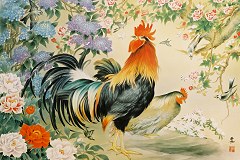 © Ozuma Kaname Cock and hen (Kaname)The long, clear call of the cockerel has made it a traditional symbol for long life. Here Kaname surrounds the cock and hen with flowers, particularly the auspicious peony, in a classic 'bird-and-flower' (kachôzu) composition. The painter Ozuma Kaname was born in 1939, in Niigata. He studied traditional Japanese art, and his pictures are generally based on traditional themes. Ozuma is his family name: he signs paintings with the single character of his given name only.  Permanently unavailable Permanently unavailableDiscontinued 2015 An Appleone puzzle: 1000 pieces; 750 x 500 mm (30" x 20") Code: A10326 (1000-326 on package) Retail price ¥3600 |
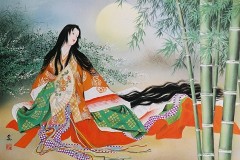 © Ozuma Kaname Kaguya-hime (Kaname)With a huge full moon as backdrop, Kaguyahime ("Princess of the shining night") has a pensive look. The story of which she is heroine, the "Bamboo cutter's tale", dates back a thousand years, to the great cultural flowering that was the Heian period. In the story, she was found as a tiny baby inside a bamboo trunk. As we see, a beauty of that time wore her eyebrows high, and her hair exceedingly long. She also spared no expense on her kimono. 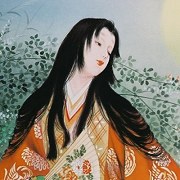 Good articles at Wikipedia: The Tale of the Bamboo Cutter - Heian period The painter Ozuma Kaname was born in 1939, in Niigata. He studied traditional Japanese art, and his pictures are generally based on traditional themes. Ozuma is his family name: he signs paintings with the single character of his given name only.  Permanently unavailable Permanently unavailableDiscontinued January 2019 An Appleone puzzle: 1000 pieces; 750 x 500 mm (30" x 20") Code: A10339 (1000-339 on package) Retail price ¥3600 |
 © Ozuma Kaname Carp ascending (Kaname)The carp is a traditional symbol of wordly success, and these two fine specimens produce a vigorous spray as they make their way up in the world. The original title, Daishôri ("Great-rise-carp") is a pun, because with different characters shôri also means "Victory". The painter Ozuma Kaname was born in 1939, in Niigata. He studied traditional Japanese art, and his pictures are generally based on traditional themes. Ozuma is his family name: he signs paintings with the single character of his given name only.  Permanently unavailable Permanently unavailableAn Appleone puzzle: 1000 pieces; 500 x 750 mm (20" x 30") Code: A10346 (1000-346 on package) Retail price ¥3600 |
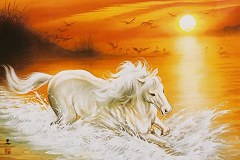 © Ozuma Kaname White stallion (Kaname)There is a tradition, we're told, that a horse will never fall to the left; in an age in which the left-handed could be safely ignored, this made the horse a symbol of prosperity and good fortune. More generally, as the commentator on the box says, a white horse is seen as a good omen in many cultures of the world. The painter Ozuma Kaname was born in 1939, in Niigata. He studied traditional Japanese art, and his pictures are generally based on traditional themes. Ozuma is his family name: he signs paintings with the single character of his given name only.  Permanently unavailable Permanently unavailableAn Appleone puzzle: 1000 pieces; 750 x 500 mm (30" x 20") Code: A10350 (1000-350 on package) Retail price ¥3600 |
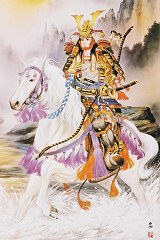 © Ozuma Kaname New warrior (Kaname)"With his back to the dawn, the new warrior cuts a heroic figure, heralding a manly future." The colourful armour looks quite a burden, but makes a splendid emblem for the Boys' Festival of May 5th.  The painter Ozuma Kaname was born in 1939, in Niigata. He studied traditional Japanese art, and his pictures are generally based on traditional themes. Ozuma is his family name: he signs paintings with the single character of his given name only.  Permanently unavailable Permanently unavailableAn Appleone puzzle: 1000 pieces; 500 x 750 mm (20" x 30") Code: A10366 (1000-366 on package) Retail price ¥3600 |
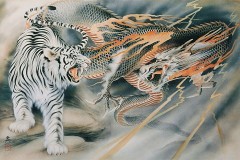 © Ozuma Kaname White tiger, blue dragon (Kaname)The classic duo from the four protector gods: the tiger quite naturalistic, but the dragon a fantastic scaly snake-like body with fierce fangs, talons, and horns.  The painter Ozuma Kaname was born in 1939, in Niigata. He studied traditional Japanese art, and his pictures are generally based on traditional themes. Ozuma is his family name: he signs paintings with the single character of his given name only.  Permanently unavailable Permanently unavailableAn Appleone puzzle: 1000 pieces; 750 x 500 mm (30" x 20") Code: A10371 (1000-371 on package) Retail price ¥3000 |
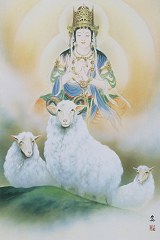 © Ozuma Kaname Dainichi Nyorai (Kaname)Painted for 2003, the year of the sheep, this lucky puzzle also features Dainichi Nyorai, one of the most senior embodiments of Buddahood. Despite a rather feminine appearance, it seems Buddha is not explicitly male or female. Notice the hands in a significant gesture: the five fingers of the right hand (five worldly elements) unified with the one from the left hand (spiritual consciousness). 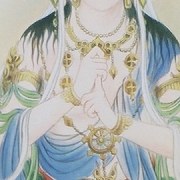 Mark Schumacher's page has an excellent explanation. The painter Ozuma Kaname was born in 1939, in Niigata. He studied traditional Japanese art, and his pictures are generally based on traditional themes. Ozuma is his family name: he signs paintings with the single character of his given name only.  Permanently unavailable Permanently unavailableAn Appleone puzzle: 1000 pieces; 500 x 750 mm (20" x 30") Code: A10400 (1000-400 on package) Retail price ¥3600 |
 © Ozuma Kaname Auspicious peacock (Kaname)A splendid peacock display, in Kaname's restrained style. This is a "Birds-and-flowers" composition, so the peacock is joined by an elegant peony in the left corner, and set against the background of a wild mountainscape. The painter Ozuma Kaname was born in 1939, in Niigata. He studied traditional Japanese art, and his pictures are generally based on traditional themes. Ozuma is his family name: he signs paintings with the single character of his given name only.  Permanently unavailable Permanently unavailableAn Appleone puzzle: 1000 pieces; 750 x 500 mm (30" x 20") Code: A10410 (1000-410 on package) Retail price ¥3600 |
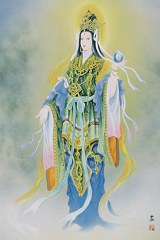 © Ozuma Kaname Kissho Tennyo (Kaname)This is the "Goddess of fortune", or "Heavenly maiden", a figure from the Buddhist tradition who portends good fortune in all aspects. Her right hand forms one of the symbolic gestures (mudra), representing the granting of wishes, and her left holds the cintamani (Sanskrit) magical jewel. (As usual, the English translations of her name are unreliable: properly speaking Buddhism has no "Goddesses".) 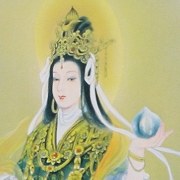 Mark Schumacher's Buddhist Corner has nothing on this deity, but a whole page on the mudra gestures. The painter Ozuma Kaname was born in 1939, in Niigata. He studied traditional Japanese art, and his pictures are generally based on traditional themes. Ozuma is his family name: he signs paintings with the single character of his given name only.  Permanently unavailable Permanently unavailableAn Appleone puzzle: 1000 pieces; 500 x 750 mm (20" x 30") Code: A10411 (1000-411 on package) Retail price ¥3600 |
 © Ozuma Kaname Moon and five monkeys (Kaname)Under a full moon, five monkeys (a family?) play in a cherry tree. Apart from 2004 being the Year of the Monkey, what significance does this have? It's a play on words: the characters for "five monkeys" can be read go-en, which could also mean "Good fortune", or refer to the presence of an honourable guest. Well, by tradition this is deemed to be a Good Title. 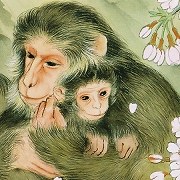 The painter Ozuma Kaname was born in 1939, in Niigata. He studied traditional Japanese art, and his pictures are generally based on traditional themes. Ozuma is his family name: he signs paintings with the single character of his given name only.  Permanently unavailable Permanently unavailableAn Appleone puzzle: 1000 pieces; 750 x 500 mm (30" x 20") Code: A10428 (1000-428 on package) Retail price ¥3600 |
 © Ozuma Kaname Wild tiger (Kaname)The tiger is a traditional symbol of strength, and is revered as a harbinger of safety and good fortune. Kaname's portrayal is naturalistic, but powerful.  The painter Ozuma Kaname was born in 1939, in Niigata. He studied traditional Japanese art, and his pictures are generally based on traditional themes. Ozuma is his family name: he signs paintings with the single character of his given name only.  Permanently unavailable Permanently unavailableDiscontinued July 2018 An Appleone puzzle: 1000 pieces; 750 x 500 mm (30" x 20") Code: A10429 (1000-429 on package) Retail price ¥3600 |
 © Ozuma Kaname Four gods (Kaname)In Chinese mythology these four gods occupy the four corners of the cosmos: the white tiger in the west, the blue dragon in the east, the red phoenix (Suzaku) in the south, and the mysterious Genbu in the north. Mysterious, because Genbu apparently turns up as a snake and a turtle entwined together, which is why there are five heads in the picture. These deities are associated with feng shui, and have also appeared in Japanese animations, so they are easy to find on the Web. The painter Ozuma Kaname was born in 1939, in Niigata. He studied traditional Japanese art, and his pictures are generally based on traditional themes. Ozuma is his family name: he signs paintings with the single character of his given name only.  Not available Not availableDiscontinued January 2025 An Appleone puzzle: 1000 pieces; 750 x 500 mm (30" x 20") Code: A10764 (1000-764 on package) Retail price ¥3200 |
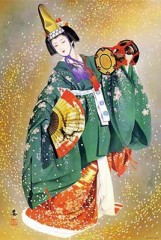 © Ozuma Kaname Asatsumabune (Kaname)A portrayal of this traditional dance — its origins are not entirely clear, but the figure seems to be based on a painting by Hanabusa Itchō (1652-1724) of a dancer on the ferry along Lake Biwa, joining Ōtsu and Asatsuma (in modern Maibara). This boat trip was an important transport link, but no opportunity was missed to provide entertainment, in the form of dancing, on board. The painter Ozuma Kaname was born in 1939, in Niigata. He studied traditional Japanese art, and his pictures are generally based on traditional themes. Ozuma is his family name: he signs paintings with the single character of his given name only.  Permanently unavailable Permanently unavailableA Yanoman puzzle: 1000 pieces; 500 x 750 mm (20" x 30") Code: Y101018 (10-1018 on package) Retail price ¥3000 |
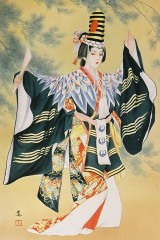 © Ozuma Kaname Sanbasô (Kaname)The character Sanbasô has a long history - stretching back over a thousand years of Noh drama. Originally a character in the drama Okina, the name (lit. "3rd person") is said to come from the fact that this character was the third to dance. Kaname here portrays the character as later adopted in kabuki, in a classic formal pose. 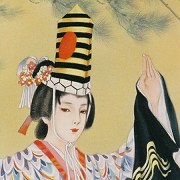 The painter Ozuma Kaname was born in 1939, in Niigata. He studied traditional Japanese art, and his pictures are generally based on traditional themes. Ozuma is his family name: he signs paintings with the single character of his given name only.  Permanently unavailable Permanently unavailableA Yanoman puzzle: 1000 pieces; 500 x 750 mm (20" x 30") Code: Y101019 (10-1019 on package) Retail price ¥3000 |
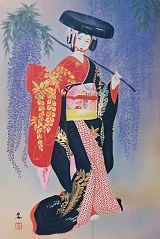 © Ozuma Kaname Fujimusume (Kaname)Fujimusume is a traditional character from Japanese dance - her name comes from fuji, wisteria (nothing to do with Mt. Fuji) and musume, means "daughter" or simply "young woman". Typically she dances on a stage set with exuberantly stylised hanging blossom; the wide black hat is another standard accessory. 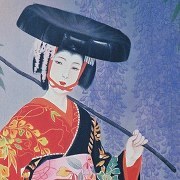 Haruyo's version of Fujimusume (1000 pieces) The painter Ozuma Kaname was born in 1939, in Niigata. He studied traditional Japanese art, and his pictures are generally based on traditional themes. Ozuma is his family name: he signs paintings with the single character of his given name only.  Permanently unavailable Permanently unavailableA Yanoman puzzle: 1000 pieces; 500 x 750 mm (20" x 30") Code: Y101027 (10-1027 on package) Retail price ¥3000 |
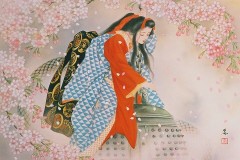 © Ozuma Kaname Kiyohime of Dôjôji (Kaname)According to the legend, there was once a girl called Kiyohime who, tormented by unrequited love for the priest Anchin of the temple of Dôjôji, eventually turned into a snake, and roasted the object of her desire inside the temple bell. Kaname here portrays the dancing girl character of the much later kabuki play, who entertains the priests (and the audience) and at the climax climbs onto the bell, and reveals herself as the spirit of Kiyohime. We are reminded of the darker side of her character by the serpentine coils behind her. 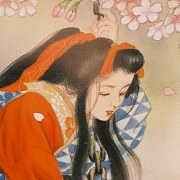 Synopsis of the kabuki version - for more sites, try Google, and search for "Musume Dojoji". The painter Ozuma Kaname was born in 1939, in Niigata. He studied traditional Japanese art, and his pictures are generally based on traditional themes. Ozuma is his family name: he signs paintings with the single character of his given name only.  Permanently unavailable Permanently unavailableA Yanoman puzzle: 1000 pieces; 750 x 500 mm (30" x 20") Code: Y101061 (10-1061 on package) Retail price ¥3000 |
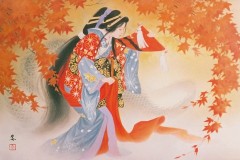 © Ozuma Kaname Takiyasha-hime (Kaname)The tragic kabuki figure Takiyasha-hime is based on a historical character, Satsuki-hime, daughter of Masakado, a member of the Taira (Heike) clan on the losing side of the great power struggle with the Minamoto clan in the 12th century (Heian period). According to the story, determined to avenge the death of her father, she went to the shrine of Kibune to obtain magic powers, and changed her name to Takiyasha-hime. We might translate this roughly as "The Witch of the Waterfall," though the -hime suffix normally refers to a "princess" or other lady figure. She tries to start a rebellion within the court, but eventually her powers are overcome, and she meets the same fate as her father. Here we see the tragic stage of the kabuki performance - she still bears the Heike flag (red with black stripes), but her hair, long in the Heian style, is dishevelled, and her pose is one of despair. The shadowy scaly tail in the background is a reminder of the magic powers that are now failing her. 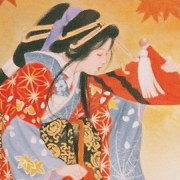 The painter Ozuma Kaname was born in 1939, in Niigata. He studied traditional Japanese art, and his pictures are generally based on traditional themes. Ozuma is his family name: he signs paintings with the single character of his given name only.  Permanently unavailable Permanently unavailableA Yanoman puzzle: 1000 pieces; 750 x 500 mm (30" x 20") Code: Y101062 (10-1062 on package) Retail price ¥3000 |
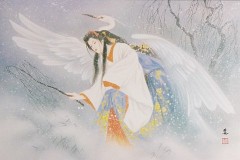 © Ozuma Kaname The heron maiden (Kaname)A story from kabuki of unrequited love: this character is a heron who has been transformed into a human, and has fallen madly in love, only to be spurned. She dances in three stages, as an unblemished maiden, as a mature beauty, and most poignantly as she returns to being a heron - the scene shown here. 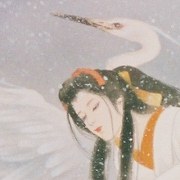 The painter Ozuma Kaname was born in 1939, in Niigata. He studied traditional Japanese art, and his pictures are generally based on traditional themes. Ozuma is his family name: he signs paintings with the single character of his given name only.  Permanently unavailable Permanently unavailableA Yanoman puzzle: 1000 pieces; 750 x 500 mm (30" x 20") Code: Y101063 (10-1063 on package) Retail price ¥3000 |
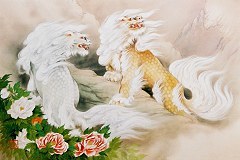 © Ozuma Kaname Shishi lions (Kaname)A splendid pair of lucky shishi, the mythical "lion" from China and Korea, whose origin is probably a reinterpretation of drawings of real lions that reached China in antiquity. In Kaname's version they have elegant flowing manes, and certainly look powerful... 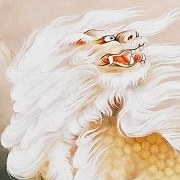 More about the shishi in Mark Schumacher's Buddhist Corner The painter Ozuma Kaname was born in 1939, in Niigata. He studied traditional Japanese art, and his pictures are generally based on traditional themes. Ozuma is his family name: he signs paintings with the single character of his given name only.  Permanently unavailable Permanently unavailableA Yanoman puzzle: 1000 pieces; 750 x 500 mm (30" x 20") Code: Y101094 (10-1094 on package) Retail price ¥3000 |
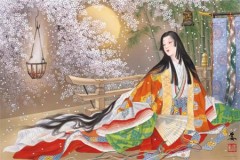 © Ozuma Kaname Kaguyahime under the spring moon (Kaname)Kagaya here portrays Kaguyahime ("Princess of the shining night") against a background of cherry blossom, though which we see a huge full moon. The "spring moon" of the title refers to oborozuki, a romantic motif in both art and song: which we can best translate as "the (spring) moon, shrouded in haze". The story of which she is heroine, the "Bamboo cutter's tale", dates back a thousand years, to the great cultural flowering that was the Heian period. In the story, she was found as a tiny baby inside a bamboo trunk. As we see, a beauty of that time wore her eyebrows high, and her hair exceedingly long. She also spared no expense on her kimono. 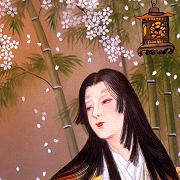 Good articles at Wikipedia: The Tale of the Bamboo Cutter - Heian period The painter Ozuma Kaname was born in 1939, in Niigata. He studied traditional Japanese art, and his pictures are generally based on traditional themes. Ozuma is his family name: he signs paintings with the single character of his given name only.  Permanently unavailable Permanently unavailableA Yanoman puzzle: 1000 pieces; 750 x 500 mm (30" x 20") Code: Y101108 (10-1108 on package) Retail price ¥3000 |
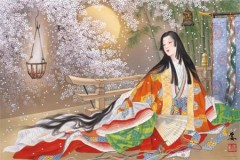 © Ozuma Kaname Kaguyahime under the spring moon (Kaname)Kagaya here portrays Kaguyahime ("Princess of the shining night") against a background of cherry blossom, though which we see a huge full moon. The "spring moon" of the title refers to oborozuki, a romantic motif in both art and song: which we can best translate as "the (spring) moon, shrouded in haze". The story of which she is heroine, the "Bamboo cutter's tale", dates back a thousand years, to the great cultural flowering that was the Heian period. In the story, she was found as a tiny baby inside a bamboo trunk. As we see, a beauty of that time wore her eyebrows high, and her hair exceedingly long. She also spared no expense on her kimono. 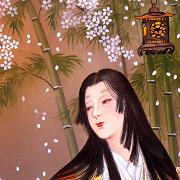 Good articles at Wikipedia: The Tale of the Bamboo Cutter - Heian period The painter Ozuma Kaname was born in 1939, in Niigata. He studied traditional Japanese art, and his pictures are generally based on traditional themes. Ozuma is his family name: he signs paintings with the single character of his given name only.
 Permanently unavailable Permanently unavailableDented box A Yanoman puzzle: 1000 pieces; 750 x 500 mm (30" x 20") Code: Y101108X (Y101108X on package) Retail price ¥3000 |
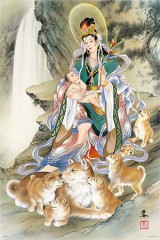 © Ozuma Kaname Dog family with Kishimojin (Kaname)The dog has long been taken as a symbol of easy childbirth, and here the litter of puppies (six in all) sit with their mother at the foot of Kishimojin. This latter has an interesting story - her name is literally "Devil-child-mother-god", and she started out as an evil character, whose favourite activity was eating other people's babies. But she was persuaded by Shaka-sama (the historical Buddha) to reform, and became a protector of children and augurer of easy childbirth. More on Kishimojin at Mark Schumacher's Buddhist Corner The painter Ozuma Kaname was born in 1939, in Niigata. He studied traditional Japanese art, and his pictures are generally based on traditional themes. Ozuma is his family name: he signs paintings with the single character of his given name only.  Permanently unavailable Permanently unavailableDiscontinued March 2023 A Yanoman puzzle: 1000 pieces; 500 x 750 mm (20" x 30") Code: Y101296 (10-1296 on package) Retail price ¥3000 |
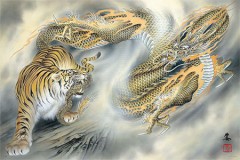 © Ozuma Kaname Tiger vs. Dragon (Kaname)The classic duo from the four protector gods: the tiger quite naturalistic, but the dragon a fantastic scaly snake-like body with fierce fangs, talons, and horns. The painter Ozuma Kaname was born in 1939, in Niigata. He studied traditional Japanese art, and his pictures are generally based on traditional themes. Ozuma is his family name: he signs paintings with the single character of his given name only.  Not available Not availableDiscontinued February 2025 A Yanoman puzzle: 1000 pieces; 750 x 500 mm (30" x 20") Code: Y101311 (10-1311 on package) Retail price ¥3200 |
500 pieces
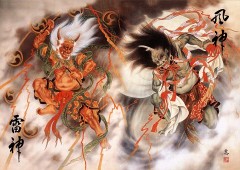 © Ozuma Kaname Gods of wind and thunder (Kaname)A traditional portrayal of this famous pair of Shinto deities - Raijin, god of thunder and lightning, and Fûjin, god of wind. Raijin has his circle of drums to beat, and Fûjin the bag with which he somehow creates the wind. (It doesn't look as though either or them cuts their toenails very often.) 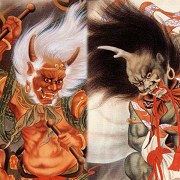 The painter Ozuma Kaname was born in 1939, in Niigata. He studied traditional Japanese art, and his pictures are generally based on traditional themes. Ozuma is his family name: he signs paintings with the single character of his given name only.  Permanently unavailable Permanently unavailableAn Appleone puzzle: 500 pieces; 530 x 380 mm (21" x 15") Code: A05188 (500-188 on package) Retail price ¥2400 |
300 pieces
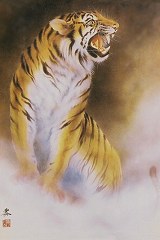 © Ozuma Kaname Tiger (Kaname)A rather naturalistic representation of the tiger, ancient symbol of strength. The painter Ozuma Kaname was born in 1939, in Niigata. He studied traditional Japanese art, and his pictures are generally based on traditional themes. Ozuma is his family name: he signs paintings with the single character of his given name only.
 Permanently unavailable Permanently unavailableAn Appleone puzzle: 300 pieces; 260 x 380 mm (10" x 15") Code: A03126 (300-126 on package) Retail price ¥2000 |
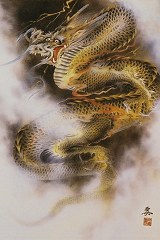 © Ozuma Kaname Dragon (Kaname)Where do dragons come from? There is a gorge called Longmen ("Dragon-gate") on the Yellow River that flows so fast it is said that any carp that managed to swim up it will turn itself into a dragon, the King of the scaly beasts. This is a "Glow-in-the-dark" puzzle, and forms a pair with A03126, the tiger. The painter Ozuma Kaname was born in 1939, in Niigata. He studied traditional Japanese art, and his pictures are generally based on traditional themes. Ozuma is his family name: he signs paintings with the single character of his given name only.
 Permanently unavailable Permanently unavailableAn Appleone puzzle: 300 pieces; 260 x 380 mm (10" x 15") Code: A03127 (300-127 on package) Retail price ¥2000 |
- 32 puzzles shown
- Explore the attics: complete list of deleted puzzles
Substituted puzzles
A10261: this puzzle reissued as A10764 - Four gods (1000pcs)
Y101082: this puzzle reissued as Y101296 - Dog family with Kishimojin (1000pcs)

 Reduced price for damaged box
Reduced price for damaged box